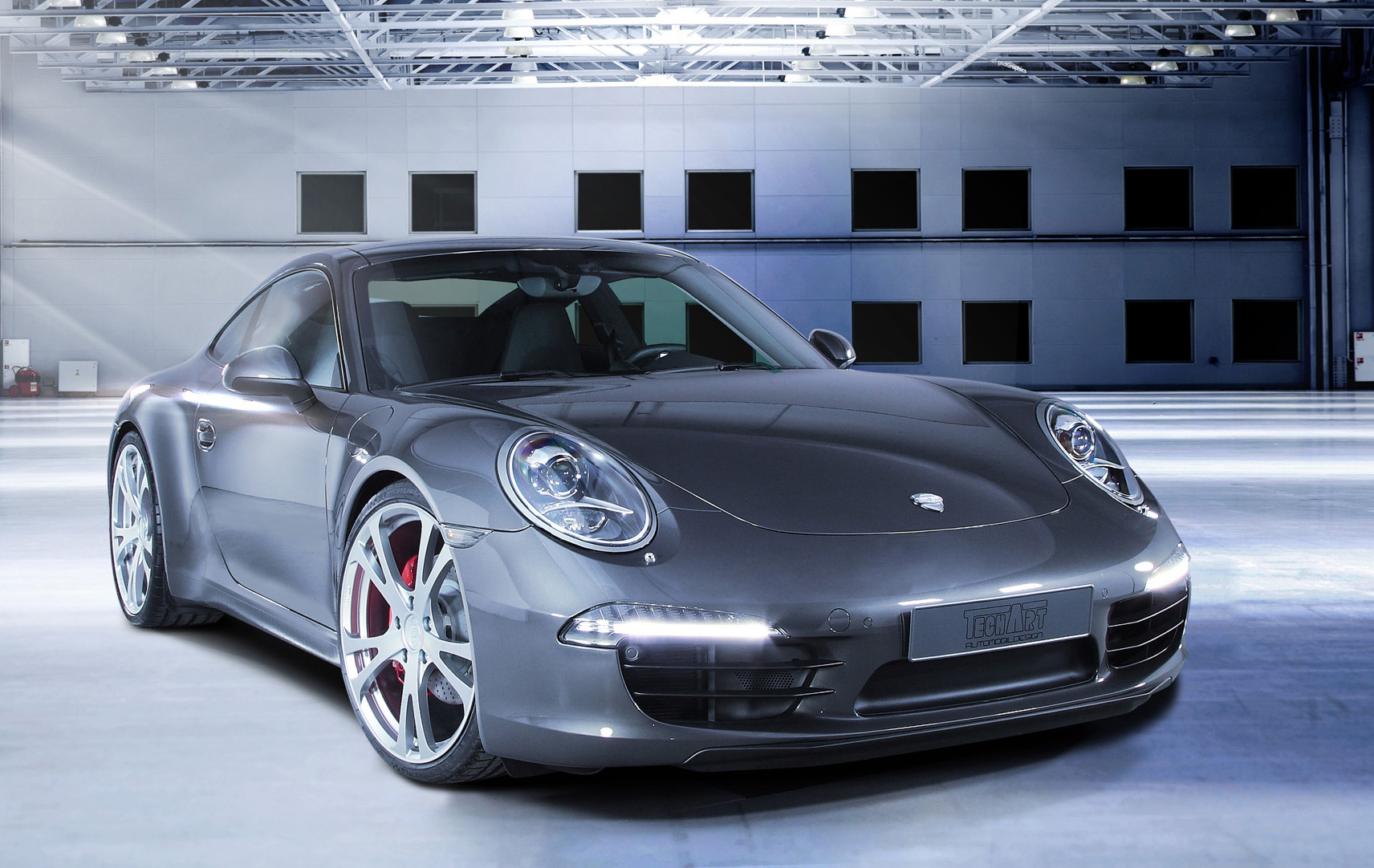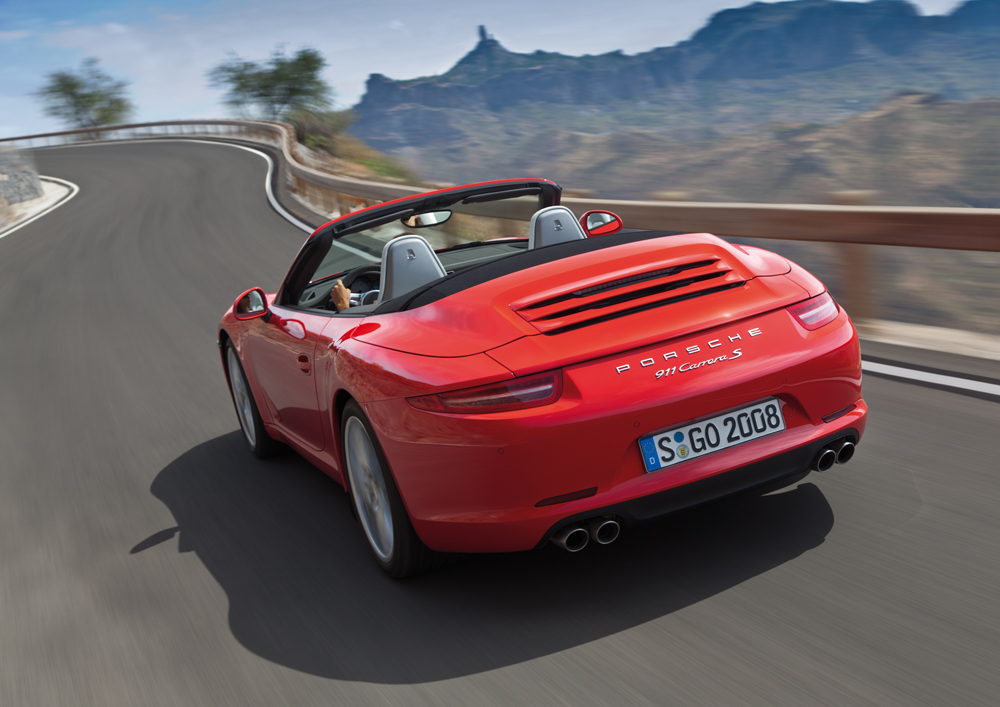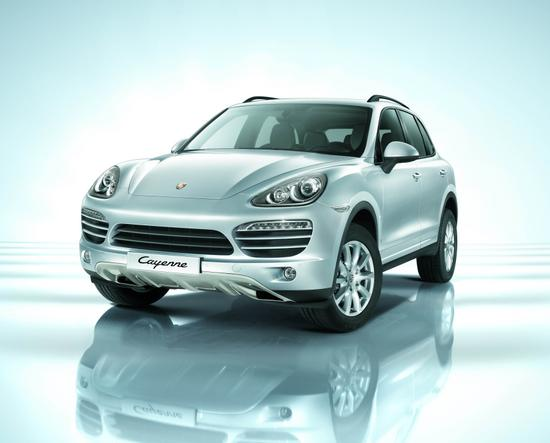
March 31, 2010 – Led by the all-new Cayenne S Hybrid, Porsche’s first production hybrid, the next-generation Cayenne sets the standard in its class in efficiency and performance. Compared to the previous Cayenne models, fuel consumption is down by up to 23 percent in the New European Driving Cycle (NEDC).
This new Cayenne, like every Porsche, was developed according to the Porsche Intelligent Performance philosophy — more power on less fuel, increased efficiency and lower CO2 emissions.
The North American Cayenne model range will include four models: the 2011 Cayenne, Cayenne S, Cayenne Turbo and the Cayenne S Hybrid. The S and Turbo models go on sale in July, with the Cayenne and Cayenne S Hybrid in dealer showrooms this fall. The Cayenne model lineup MSRPs are are follows: Cayenne, $46,700; Cayenne S, $63,700; Cayenne S Hybrid, $67,700; and Cayenne Turbo, $104,800.
The highlight is the new Cayenne S Hybrid featuring a highly sophisticated parallel full hybrid system. With a combined power output of 380 horsepower from the supercharged V6 combustion engine and an electric motor, the Cayenne S Hybrid combines the performance of a V8 with the economy of a V6.
Through continuous interaction between the 3.0-liter supercharged V6 and electric motor, the Cayenne S Hybrid focuses on maximum efficiency. Depending on driving conditions, either drive unit can operate independently or together. The 47-horsepower (34 kW) electric motor is the ideal partner for the 333-horsepower engine, which produces high torque at low engine speeds, with peak torque at 428 lb-ft at just 1,000 rpm.
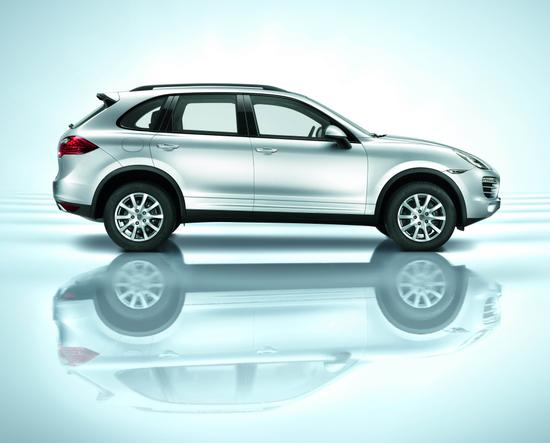
Three Cayenne flavors have two main ingredients: performance and efficiency
While the new entry level Cayenne has a 300-horspower 3.6-liter V6 engine, thanks in part to the new eight-speed Tiptronic S automatic transmission it is approximately 20 percent more fuel efficient in the NEDC than the previous model.
The high-torque Cayenne S with its 4.8-liter V8 likewise shows a significant decrease in fuel consumption, down by 23 percent in the NEDC. At the same time engine output is now 400 horsepower compared to 385 horsepower in the former Cayenne S. And similarly the range-topping Cayenne Turbo with its 500-horsepower, twin-turbocharged, 4.8-liter V8 is 23 percent more fuel efficient than its predecessor.
In addition to Porsche’s new eight-speed Tiptronic S transmission with a wide range of gear ratios, other factors also contribute to this reduction in fuel consumption. Specifically this includes the Automatic Start Stop function (first introduced on the Panamera), efficient thermal management of the engine and transmission cooling circuits, on-board electrical network recuperation, variable deceleration fuel cut-off and the Cayenne’s intelligent lightweight construction.
Thanks to the combination of material weight minimization and overall changes in the vehicle concept such as the new, active and extra-light all-wheel drive system, overall weight for the Cayenne S is down by a substantial 396 lbs. The benefits are not only better fuel consumption and lower CO2 emissions, but also improved performance, agility and handling.
The Cayenne and Cayenne S Hybrid consume less than 10 liters of fuel per 100 kilometers in the NEDC, and the Cayenne S Hybrid, emitting just 193 g/km, is not only the cleanest Cayenne model but also the cleanest vehicle in Porsche’s entire portfolio.
Hybrid Manager seamlessly coordinates the two power units
Again, the Cayenne S Hybrid is Porsche’s first production hybrid. Its electric motor and its supercharged V6 are connected to one another by a decoupling clutch, which ensures that the Cayenne S Hybrid may be driven either by the electric motor or the combustion engine alone, or by both drive units together. The Hybrid Manager constantly coordinates their complex interaction, and intelligent management of the clutch makes the transition among various driving modes seamless and comfortable.
Like many hybrids, the Cayenne S Hybrid can cover short distances on electric power alone, free of emissions and noise up to 60 km/h or almost 40 mph. For aggressive acceleration, the motor provides an extra ‘boost’ to the gasoline engine.
The hybrid system uses a 288-volt nickel metal-hydride (NiMh) battery fitted beneath the luggage compartment and regenerative braking, the process of storing electricity regained from applying the brakes and driving under normal conditions. This energy is then available for boosting and electric drive, again saving fuel in the process.
Additional savings potential by ‘sailing’ up to 97 mph
Using the decoupling clutch, the Cayenne S Hybrid also has the potential to further enhance fuel economy at high speeds. Christened by the Weissach engineers as ‘sailing’ – or coasting – mode, when the Cayenne S Hybrid does not need drive power and the driver lifts off the accelerator at speeds up to 97 mph, the gasoline engine can be completely switched off and disengaged from the drivetrain, enabling the vehicle to move along without combustion or electric power.
This means a significant reduction of fuel consumption at steady highway speeds, with engine drag forces and their braking effect being eliminated to reduce driving resistance. As soon as the driver presses the accelerator in the sailing mode, to pass another vehicle for example, the gasoline engine smoothly starts within fractions of a second and engine rpms are increased to match the current vehicle speed. Thanks to the Hybrid Manager, the Cayenne S Hybrid is able to accelerate dynamically in gears at higher speeds much like a conventional gasoline-powered Cayenne.
New active all-wheel drive with electronically controlled multiple-plate clutch
Porsche has developed an active all-wheel-drive system for the new Cayenne driving the rear wheels and transmitting power to the front wheels as needed through an electronically controlled, map-based multiple-plate clutch.
Porsche selected this technology to reduce weight and make the new Cayenne even more agile on the road. But at the same time the Cayenne offers all the off-road capabilities a driver needs under normal conditions.
For the first time this active all-wheel drive system can be paired with Porsche’s new Porsche Torque Vectoring (PTV) Plus option. PTV Plus uses variable torque distribution on the rear wheels as well as an electronically controlled rear axle differential lock, thus increasing both driving dynamics and stability in curves.
This new all-wheel-drive system with its high standard of driving dynamics is featured on the Cayenne, the Cayenne S and the Cayenne Turbo. The Cayenne S Hybrid comes with permanent all-wheel drive incorporating a self-locking center differential.
Superior suspension with various options for enhanced driving characteristics
Porsche’s engineers have succeeded in making the Cayenne’s outstanding driving abilities significantly better. The name of the game again is lightweight engineering. For instance, the Cayenne chassis is now 145 lbs lighter thanks in part to the use of aluminum.
All Cayenne models except the Cayenne Turbo come with steel suspension as standard equipment, but for the first time it can be combined with Porsche Active Suspension Management (PASM) as an option. PASM is a highly sophisticated system providing active, infinite damper control on the front and rear axle. It offers the choice of the three settings: Comfort, Normal, and Sport.
The Cayenne Turbo comes with a new air suspension system with PASM as standard equipment (available as an option on the other models). A Cayenne, Cayenne S and Cayenne Turbo with air suspension and PASM may be further enhanced with Porsche Dynamic Chassis Control (PDCC), an optional system that actively stabilizes the vehicle through dynamic distribution of roll forces.
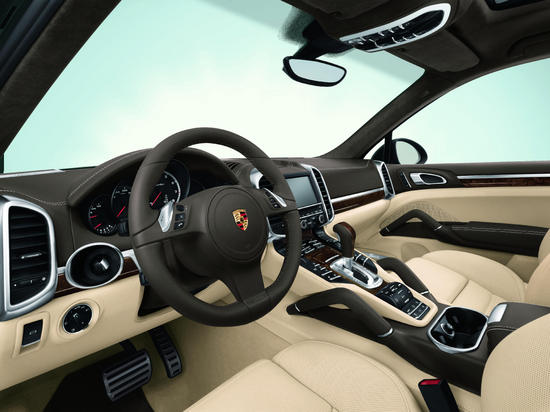
Exterior and interior design: elegance in a new dimension
The completely new Cayenne design leaves no doubt that it is part of the Porsche family. Its sporting character is evident from all angles, and its Porsche shape and design highlights are more distinct than ever before.
It is 1.9 inches longer than its predecessor, and an added 1.6 inches in wheelbase ensures extra space and greater versatility. But despite larger exterior dimensions, the new Cayenne looks far more compact and dynamic.
The new headlights resemble those on other Porsches, with the high-beam lamps positioned closer to the centerline of the car and the low-beams toward the outer edge. The Porsche family resemblance continues at the rear with quarter panels flowing to the back and accentuating the Cayenne’s broad shoulders.
Inside, the luxurious interior features a high center console that like the original Carrera GT and now the Panamera rises up at an incline to meet the dashboard center stack with high-quality fittings and a touch-screen infotainment interface to provide a cockpit-like environment up front. The center console grab handles that were present in the original Cayenne are still there, yet with a new design that is carried over to all four doors.
Rear-seat comfort is much improved, as well, thanks to the extended wheelbase. The bench seat now slides fore-and-aft by 6.3 inches, and the backrest can be adjusted to three different angles, or up to 6 degrees.
Porsche’s traditional set of five round instruments in the drivers gauge cluster includes a high-resolution circular 4.8-inch TFT screen to the right of the tachometer. It can be used to change radio stations, vehicle settings, or access the navigation system or view the map. The Cayenne S Hybrid instrument cluster differs as the instruments provide the driver with all technical details related to the car’s innovative hybrid system.
The new Cayenne comes with the latest generation of audio and communication systems found in the new Panamera, with Bose® Surround Sound System and the Burmester® High-End Surround Sound System.
New systems, some even featured as standard
For the U.S. market, all Cayenne models include Bluetooth telephone connectivity and the universal audio interface to connect an external audio source such as an iPod or a USB stick with the Porsche Communication Management (PCM) system as standard equipment. Servotronic speed-sensitive power steering and a moonroof is standard on the Cayenne S, Cayenne S Hybrid and Cayenne Turbo.
Porsche also offers a range of systems for the new Cayenne to help the driver, including Porsche Dynamic Light System (PDLS). PDLS is a further development of the existing Bi-Xenon® light system and offers not only dynamic and static cornering lights, but also for the first time in the Cayenne speed-sensitive headlight control with separate modes for roads and interstates. The system is standard on the Cayenne Turbo and an option on the other models.
Another new option is the Lane Change Assistant (LCA). This driver aid monitors the adjacent lanes up to a distance of 230 feet behind the vehicle, including the driver’s blind spots. As soon as another vehicle enters the blind spots or approaches rapidly from behind within a range of 180 feet, an LED warning light illuminates on the inside of the corresponding exterior mirror. If the driver uses the turn signal, the flashing light appears to alert the driver of the approaching vehicle.
Cruise control is standard equipment on all Cayenne models. Customers can also opt for the optional Adaptive Cruise Control system. This driver aid uses a radar sensor to monitor the space between the Cayenne and the vehicle ahead and maintains your preset distance. It does this by restricting the throttle or gently applying the brakes to maintain the preset distance. If the vehicle in front continues to decelerate, Adaptive Cruise Control will reduce cruising speed – even down to a stop. To set off again after coming to a halt, all the driver has to do is briefly press the control lever or the gas pedal.
Adaptive Cruise Control operates at speeds from 20 to 100 mph, and the required braking power, as calculated by the system, is provided by Porsche Stability Management (PSM) actively building up brake pressure. This provides active safety benefits to the driver. If the distance between the Cayenne and the vehicle ahead becomes too small, the system alerts the brake standby function to shorten the stopping distance required. It also pre-fills the brake system for quicker response and gives the driver both a visual and an acoustic warning and an additional brake pulse as an added driver warning in risky or possibly dangerous situations.
Source: Porsche Press Release
Photos Courtesy Porsche Cars, NA


